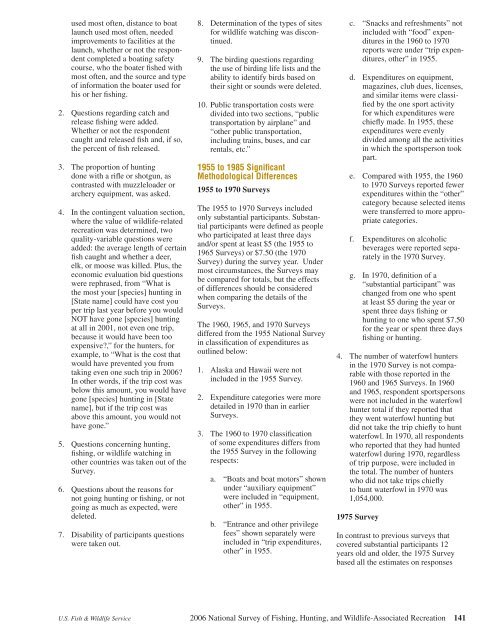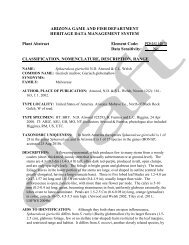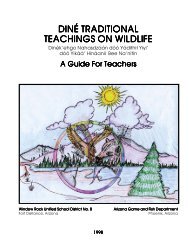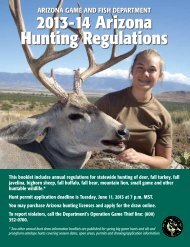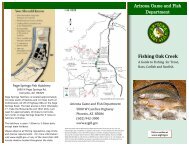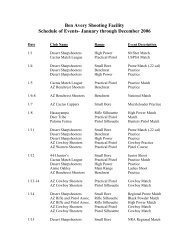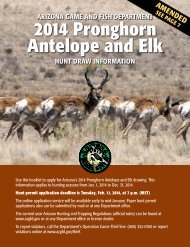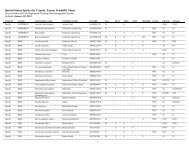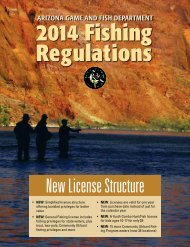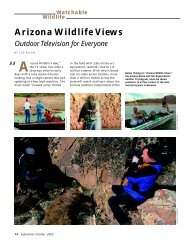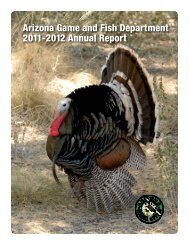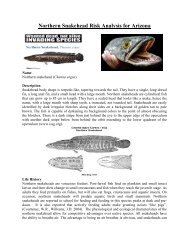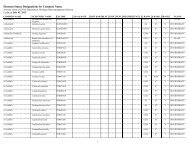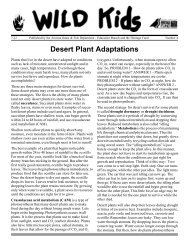2006 National Survey of Fishing, Hunting, and Wildlife-Associated ...
2006 National Survey of Fishing, Hunting, and Wildlife-Associated ...
2006 National Survey of Fishing, Hunting, and Wildlife-Associated ...
Create successful ePaper yourself
Turn your PDF publications into a flip-book with our unique Google optimized e-Paper software.
used most <strong>of</strong>ten, distance to boat<br />
launch used most <strong>of</strong>ten, needed<br />
improvements to facilities at the<br />
launch, whether or not the respondent<br />
completed a boating safety<br />
course, who the boater fished with<br />
most <strong>of</strong>ten, <strong>and</strong> the source <strong>and</strong> type<br />
<strong>of</strong> information the boater used for<br />
his or her fishing.<br />
2. Questions regarding catch <strong>and</strong><br />
release fishing were added.<br />
Whether or not the respondent<br />
caught <strong>and</strong> released fish <strong>and</strong>, if so,<br />
the percent <strong>of</strong> fish released.<br />
3. The proportion <strong>of</strong> hunting<br />
done with a rifle or shotgun, as<br />
contrasted with muzzleloader or<br />
archery equipment, was asked.<br />
4. In the contingent valuation section,<br />
where the value <strong>of</strong> wildlife-related<br />
recreation was determined, two<br />
quality-variable questions were<br />
added: the average length <strong>of</strong> certain<br />
fish caught <strong>and</strong> whether a deer,<br />
elk, or moose was killed. Plus, the<br />
economic evaluation bid questions<br />
were rephrased, from “What is<br />
the most your [species] hunting in<br />
[State name] could have cost you<br />
per trip last year before you would<br />
NOT have gone [species] hunting<br />
at all in 2001, not even one trip,<br />
because it would have been too<br />
expensive,” for the hunters, for<br />
example, to “What is the cost that<br />
would have prevented you from<br />
taking even one such trip in <strong>2006</strong><br />
In other words, if the trip cost was<br />
below this amount, you would have<br />
gone [species] hunting in [State<br />
name], but if the trip cost was<br />
above this amount, you would not<br />
have gone.”<br />
5. Questions concerning hunting,<br />
fishing, or wildlife watching in<br />
other countries was taken out <strong>of</strong> the<br />
<strong>Survey</strong>.<br />
6. Questions about the reasons for<br />
not going hunting or fishing, or not<br />
going as much as expected, were<br />
deleted.<br />
7. Disability <strong>of</strong> participants questions<br />
were taken out.<br />
8. Determination <strong>of</strong> the types <strong>of</strong> sites<br />
for wildlife watching was discontinued.<br />
9. The birding questions regarding<br />
the use <strong>of</strong> birding life lists <strong>and</strong> the<br />
ability to identify birds based on<br />
their sight or sounds were deleted.<br />
10. Public transportation costs were<br />
divided into two sections, “public<br />
transportation by airplane” <strong>and</strong><br />
“other public transportation,<br />
including trains, buses, <strong>and</strong> car<br />
rentals, etc.”<br />
1955 to 1985 Signifi cant<br />
Methodological Differences<br />
1955 to 1970 <strong>Survey</strong>s<br />
The 1955 to 1970 <strong>Survey</strong>s included<br />
only substantial participants. Substantial<br />
participants were defined as people<br />
who participated at least three days<br />
<strong>and</strong>/or spent at least $5 (the 1955 to<br />
1965 <strong>Survey</strong>s) or $7.50 (the 1970<br />
<strong>Survey</strong>) during the survey year. Under<br />
most circumstances, the <strong>Survey</strong>s may<br />
be compared for totals, but the effects<br />
<strong>of</strong> differences should be considered<br />
when comparing the details <strong>of</strong> the<br />
<strong>Survey</strong>s.<br />
The 1960, 1965, <strong>and</strong> 1970 <strong>Survey</strong>s<br />
differed from the 1955 <strong>National</strong> <strong>Survey</strong><br />
in classification <strong>of</strong> expenditures as<br />
outlined below:<br />
1. Alaska <strong>and</strong> Hawaii were not<br />
included in the 1955 <strong>Survey</strong>.<br />
2. Expenditure categories were more<br />
detailed in 1970 than in earlier<br />
<strong>Survey</strong>s.<br />
3. The 1960 to 1970 classification<br />
<strong>of</strong> some expenditures differs from<br />
the 1955 <strong>Survey</strong> in the following<br />
respects:<br />
a. “Boats <strong>and</strong> boat motors” shown<br />
under “auxiliary equipment”<br />
were included in “equipment,<br />
other” in 1955.<br />
b. “Entrance <strong>and</strong> other privilege<br />
fees” shown separately were<br />
included in “trip expenditures,<br />
other” in 1955.<br />
c. “Snacks <strong>and</strong> refreshments” not<br />
included with “food” expenditures<br />
in the 1960 to 1970<br />
reports were under “trip expenditures,<br />
other” in 1955.<br />
d. Expenditures on equipment,<br />
magazines, club dues, licenses,<br />
<strong>and</strong> similar items were classified<br />
by the one sport activity<br />
for which expenditures were<br />
chiefly made. In 1955, these<br />
expenditures were evenly<br />
divided among all the activities<br />
in which the sportsperson took<br />
part.<br />
e. Compared with 1955, the 1960<br />
to 1970 <strong>Survey</strong>s reported fewer<br />
expenditures within the “other”<br />
category because selected items<br />
were transferred to more appropriate<br />
categories.<br />
f. Expenditures on alcoholic<br />
beverages were reported separately<br />
in the 1970 <strong>Survey</strong>.<br />
g. In 1970, definition <strong>of</strong> a<br />
“substantial participant” was<br />
changed from one who spent<br />
at least $5 during the year or<br />
spent three days fishing or<br />
hunting to one who spent $7.50<br />
for the year or spent three days<br />
fishing or hunting.<br />
4. The number <strong>of</strong> waterfowl hunters<br />
in the 1970 <strong>Survey</strong> is not comparable<br />
with those reported in the<br />
1960 <strong>and</strong> 1965 <strong>Survey</strong>s. In 1960<br />
<strong>and</strong> 1965, respondent sportspersons<br />
were not included in the waterfowl<br />
hunter total if they reported that<br />
they went waterfowl hunting but<br />
did not take the trip chiefly to hunt<br />
waterfowl. In 1970, all respondents<br />
who reported that they had hunted<br />
waterfowl during 1970, regardless<br />
<strong>of</strong> trip purpose, were included in<br />
the total. The number <strong>of</strong> hunters<br />
who did not take trips chiefly<br />
to hunt waterfowl in 1970 was<br />
1,054,000.<br />
1975 <strong>Survey</strong><br />
In contrast to previous surveys that<br />
covered substantial participants 12<br />
years old <strong>and</strong> older, the 1975 <strong>Survey</strong><br />
based all the estimates on responses<br />
U.S. Fish & <strong>Wildlife</strong> Service <strong>2006</strong> <strong>National</strong> <strong>Survey</strong> <strong>of</strong> <strong>Fishing</strong>, <strong>Hunting</strong>, <strong>and</strong> <strong>Wildlife</strong>-<strong>Associated</strong> Recreation 141


